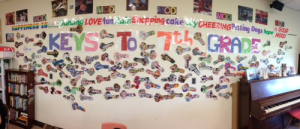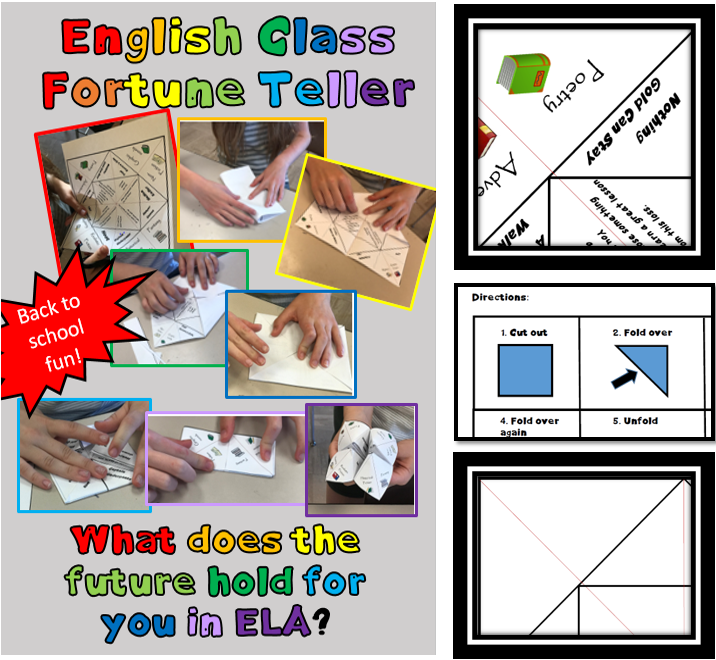Welcome! This blog has been updated on June 20, 2017!
I always have student teachers and colleagues asking, “How do you run the first day of school?” Well, after 18 first days of school, I have some suggestions. But, this is a link to a back to school digital storytelling project ! It’s one of my newest products created to get to know your students using the latest technology. It’s interactive and relevant to the students! Check it out in my store! But first, check out this free sample of a handout that I give to my students in the spring and place on my website as well: Avoiding Summer Brain Drain.
! It’s one of my newest products created to get to know your students using the latest technology. It’s interactive and relevant to the students! Check it out in my store! But first, check out this free sample of a handout that I give to my students in the spring and place on my website as well: Avoiding Summer Brain Drain.
1. Make sure every student has a place. What I mean by this is, when the students are entering your classroom on the first day of school, they want a place to go. They are nervous, confused (for some it might be their first day of middle school) and they need a seat assignment. I’ve done this several ways: handing them a number on their way in and they find the table with that number; displaying a seating chart on the document camera, or placing their name on an index card and they find it on the desk. I really prefer the document camera because it requires them to read the chart, navigate themselves through the classroom, and helps them to become familiar with the room.
Click here to see my Back to School Mega Bundle!
2. Make the room inviting. At the end of the school year, I have my students create a “key to seventh grade”. This is a colorful bulletin board that gives suggestions and tips for incoming seventh graders. You could always do this on a larger scale yourself. I also hand up motivational posters, have personal pictures, and plants to make a “homey” feel. I always ask the students to look around the room on the first day and make observations and predictions based on the room itself. Check out the photograph of my bulletin board:
3. Don’t overload your students with the “rules and regulations” – they get this ALL DAY. Yes, I distribute a course outline, but I graze over it. What I really like to do is model and practice classroom routines. For example, when the students walk into my classroom, they pick up any handouts they will need in class that day. So, I actually have the students get out of their seats, walk back into the hallway, and enter the classroom by picking up the handout and taking their assigned seat. In addition, I make them greet me on their way in and I give them a warm welcome into the class. This helps students understand that their expectations are to enter the classroom, pick up any necessary materials, and take their assigned seat.
4. Start with a “get to know you” activity! Students are always nervous on the first day of school. Try some easy activities and begin teaching! I always begin with discussing homophones. It’s a term not all students remember, but the know words like to, two, too. I have them brainstorm a list of homophones and we discuss them. But my newest product is going to cut the ice! It is a “Fortune Teller” foldable activity specifically for ELA. It’s probably best to use with upper elementary or middle school students. You can check it out here! But, students cut and fold the fortune teller then play with it with a partner. One student chooses a genre and then count the number of letters in the genre. Then the students pick a title of a book or poem. Again, count the letters in the title to find your fortune. When they choose the last title, it will unfold for a fortune that reflects some type of theme in the book! It even includes a blank one to create your own!
5. Set a daily routine. After the first three steps have been completed, I address the students to their “bell work” and how they will expect class to run each day. I have a specific place on my chalkboard that the students must fill into their agenda each day for the class assignments, upcoming events, or messages to home. Some days this might simply say, “Pleasure read tonight”. But, it ALWAYS says something. I tell students to expect homework each night, however many nights are simply to pleasure read. Getting them in the habit of writing their assignments down in one place each day also helps with organization (which is often a challenge for middle school students). However, that’s an entire post in itself. On the first day of school it reads, “Complete interview tonight”. Yes – I give them homework on the first day of school (it’s really more for dramatic purposes though). Then, I direct the students to the front screen where I will have their “bell work” each day. On the first day of school it reads, “look over the course outline”. Again, it just gives the kids some security.
6. Refer back to their previous grade! Students find comfort in what they already know. I like to remind them of the summer reading they were assigned in the last school year and just discuss what they read and share experiences. This gives them comfort in the familiar, however reminding them that they will have a task due based from their summer reading soon (wink, wink). Just for reference, here is a link of the summer reading expectation from my school: http://www.grandislandschools.org/resources.cfm?subpage=5269
7. Complete an activity that will help you get to know your students! As I said earlier, kids are overwhelmed on the first day of school with rules and regulations. I try to complete a fun “get to know you” type of activity that the kids can just talk about themselves and things they love. I also try to get the kids thinking about goal setting. Because middle schoolers LOVE taking selfies, my first day of school activity is a goal setting worksheet, “Dear Future Selfie”.
7. Assign Homework! Yes, I said it! The kids are shocked, curious, and excited to do this. I love the element of surprise when I assign homework on the first day of school. Basically, the kids go home and interview an adult on how they use reading, writing, listening and speaking in their daily lives. It helps the students to gain purpose and to allow them to see the relevancy of ELA first hand. On the second day of school, we discuss their interview results. Again, this activity allows students to bring in what is familiar to them to successfully begin to build trust between teacher and student. First Day of School Interview Assignment.
Because you’re reading this blog, I have the two visually appealing, worksheets bundled together here. I really hope this helps you on the first day of school! Have a great year!





